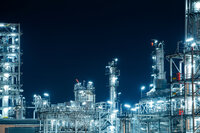
1. Determine the ATEX zone.
The first step is to determine the appropriate ATEX zone, based on the presence of explosive gases or dust in the environment. Zones are classified as follows:For gas environments:
- Zone 0: Explosive atmosphere is always or almost always present.
- Zone 1: Explosive atmosphere is likely under normal conditions.
- Zone 2: Explosive atmosphere is unlikely but may occur briefly.
- Zone 20: Dust is always or continuously present in explosive concentrations.
- Zone 21: Dust may be present in explosive concentrations under normal conditions.
- Zone 22: Dust is unlikely but may be present in explosive concentrations for a short period of time.
2. Choose the right protection for the ATEX zone.
ATEX lighting is certified for specific zones, and it is crucial to choose the right protection method for the zone in which the lighting will be installed. The most common protection methods are:- Ex d (pressure protected): Suitable for gas environments where the lighting can safely withstand an explosion within the enclosure.
- Ex e (increased safety): For situations where extra protection is needed against sparks or overheating, often used in gas environments.
- Ex p (overpressure protection): Lighting is placed under overpressure to prevent the entry of explosive substances.
- Ex n (normal operation): For environments where the probability of an explosive atmosphere is low but may be present.
3. Check the temperature class
The temperature class of the linear ATEX lighting is important to ensure that the lighting does not cause ignition in the explosive atmosphere. The temperature class determines the maximum surface temperature of the lighting, which must be lower than the ignition temperature of the substances present.The temperature classes are:
- T1: Max. 450°C
- T2: Max. 300°C
- T3: 200°C max.
- T4: Max. 135°C
- T5: Max. 100°C
- T6: Max. 85°C
4. Pay attention to the protection rating (IP rating).
The IP (Ingress Protection) rating indicates how well the lighting is protected from dust and water. The IP rating consists of two digits:- The first digit (0-6) indicates protection against dust.
- The second digit (0-9) gives the protection against water.
A minimum IP65 is required for ATEX environments, which means the lighting is completely dustproof and resistant to water jets.
5. Choose the right length and mounting options
Linear explosion-proof lights come in different lengths and can be mounted in different ways depending on the environment and type of installation. Make sure the lighting is the right length to evenly illuminate the area and is appropriate for the installation conditions (e.g., wall mount, ceiling mount, etc.).6. Check certifications and standards
Always check the lighting's ATEX & IECEx certifications. Lighting must comply with relevant ATEX standards, such as:- Ex II 2 G: Suitable for gas environments (zones 1 and 2).
- Ex II 2 D: Suitable for dust environments (zones 21 and 22).
Ensure that the lighting is approved by an accredited body and complies with European directives (e.g. ATEX 2014/34/EU).
Summary
To choose the right ATEX linear lighting:- Determine the ATEX zone (gas or dust) and associated hazards.
- Choose the appropriate protection method (Ex d, Ex e, Ex p, etc.) for the zone.
- Check the temperature class of the lighting.
- Ensure proper IP rating for protection against dust and water.
- Check length and mounting options.
- Always check the lighting's ATEX certifications and standards.
If you are interested in our ATEX range, check out our large selection here.
Need advice?
Choosing the right ATEX lighting depends on your specific situation and wishes. Ask our lighting consultants for advice. They will gladly advise you without any obligation and can answer all your questions.You can reach us in many ways:
Phone: +31 (0)85 - 0060455
Whatsapp: +31 (0)85 - 0060455
E-mail: sales@vocare-ledlight.com
Chatting via the chat function at the bottom of your screen.
Feel free to contact us and we will be happy to tell you more about the possibilities.